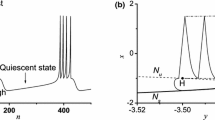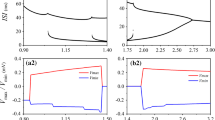Abstract
We investigate the response characteristics of a generalized FitzHugh-Nagumo model under an external sinusoidal current and the synchronization of two neurons coupled with a gap junction. In the autonomous case, we find analytically by the Lindsted’s method that the system can admit tristable activities in silence, subthreshold, and nerve pulse; depending on the conductance parameters and the state of ionic conductance. In the presence of an external sinusoidal current, we find by numerical simulations that neurons can exhibit a coexistence between different spiking patterns and periodic waves, which are well observed in the structure of the recurrence plot. We further study the synchronization between coupled neurons each admitting bistable activities, such as a coexistence between chaotic (active) and silence (inactive) regimes. We apply recurrence analysis tool to reveal the range of the coupling parameter where synchronization occurs, as well as the dynamical transitions between the synchronous coexisting states (hysteresis phenomenon). The coupling strength is an indicator of the phenomenon of synchronization that can also bring the system to any of the desired synchronous attractors. These phenomena of synchronization and the control between synchronous states can be improved by the presence of an external electrical field. The switching of the coupled neurons to bursting patterns or to periodic waves explains the well-known properties of excitatory (switching on) or inhibitory (switching off) synaptic coupling, respectively; while the unstable signal separating the two stable synchronous signals can be taken as the synaptic threshold. Rather, this study adds to our theoretical understanding of the topic and poses new challenges for investigation. Experimental investigations are required to validate these conclusions in real-world settings, and biological implications must be evaluated within the particular framework of the modeling that was done.













Similar content being viewed by others
Data availability
The data from simulations that support the findings of this study are available on request from the Potsdam Institute for Climate Impact Research (PIK).
References
Eckmann, J.P., Oliffson Kamphorst, S., Ruelle, D.: Recurrence plots of dynamical systems. Europhys. Lett. 4, 973–977 (1987)
Marwan, N., Romano, M.C., Thiel, M., Kurths, J.: Recurrence plots for the analysis of complex systems. Phys. Rep. 438, 237–329 (2007)
Trulla, L.L., Giuliani, A., Zbilut, C.L., Webber, J.: Recurrence quantification analysis of the logistic equation with transients. Phys. Lett. A 223(4), 255–260 (1996). https://doi.org/10.1016/S0375-9601(96)00741-4
Ngamga, E.J., Nandi, A., Ramaswamy, R., Romano, M.C., Thiel, M., Kurths, J.: Recurrence analysis of strange nonchaotic dynamics. Phys. Rev. E 75(3), 036222 (2007). https://doi.org/10.1103/PhysRevE.75.036222
Romano, M.C., Thiel, M., Kurths, J., Kiss, I.Z., Hudson, J.: Detection of synchronization for non-phase-coherent and non-stationary data. Euro- Phys. Lett. 71(3), 466–472 (2005). https://doi.org/10.1209/epl/i2005-10095-1
Facchini, A., Mocenni, C., Marwan, N., Vicino, A., Tiezzi, E.: Nonlinear time series analysis of dissolved oxygen in the Orbetello Lagoon (Italy). Ecol. Modell. 203(3–4), 339–348 (2007). https://doi.org/10.1016/j.ecolmodel.2006.12.001
Proulx, R., Côté, P., Parrott, L.: Multivariate recurrence plots for visualizing and quantifying the dynamics of spatially extended ecosystems. Ecol. Complex. 6(1), 37–47 (2009). https://doi.org/10.1016/j.ecocom.2008.10.003
Nkomidio, Aissatou Mboussi, Ngamga, Eulalie Ketchamen, Nbendjo, Blaise Romeo Nana., Kurths, Jurgen, Marwan, Norbert: Recurrence-based synchronization analysis of weakly coupled bursting neurons under external ELF fields. Entropy 24, 235 (2022). https://doi.org/10.3390/e24020235
Kyrtsou, C., Vorlow, C.E.: Complex Dynamics in Macroeconomics: A Novel Approach 223–238, 11 (2005). https://doi.org/10.1007/3-540-28556-3
Bigdeli, N., Afshar, K.: Characterization of Iran electricity market indices with pay-as-bid payment mechanism. Physica A 388(8), 1577–1592 (2009). https://doi.org/10.1016/j.physa.2009.01.003
Nichols, J.M., Trickey, S.T., Seaver, M.: Damage detection using multivariate recurrence quantification analysis. Mech. Syst. Signal Process. 20(2), 421–437 (2006). https://doi.org/10.1016/j.ymssp.2004.08.007
Sen, A.K., Longwic, R., Litak, G., Górski, K.: Analysis of cycle-to-cycle pressure oscillations in a diesel engine. Mech. Syst. Signal Process. 22(2), 362–373 (2008). https://doi.org/10.1016/j.ymssp.2007.07.015
Goswami, B., Ambika, G., Marwan, N., Kurths, J.: On interrelations of recurrences and connectivity trends between stock indices. Physica A 391, 4364–4376 (2012)
Hodgkin, A.L., Huxley, A.F.: A quantitative description of membrane current and its application to conduction and excitation in nerve. J Physiol 117, 500–544 (1952)
Moris, C., Lecar, H.: Voltage oscillations in the barnacle giant muscle fiber. Biophys J 35, 193–213 (1981)
Tagne Nkounga, I.B., Moukam Kakmeni, F.M., Camara, B.I., Yamapi, R.: Controling switching between birhythmic states in a new conductance-based bursting neuronal model. Nonlinear Dyn. 107(10), 2887–2902 (2022). https://doi.org/10.1007/s11071-021-07134-3
Tagne Nkounga, I., Moukam Kakmeni, F.M., Yamapi, R.: birhythmic oscillations and global stability analysis of a Conductance-based neuronal model under channel fluctuations. Chaos Solitons Fractals 159, 112126 (2022)
Tagne Nkounga, I.B., Messée, G., Yamapi, R., Kurths, J.: Switching from active to non active states in a conductance-based neuronal model under electromagnetic induction. Nonlinear Dyn. 111, 771–788 (2022). https://doi.org/10.1007/s11071-022-07842-4
FitzHugh, R.: Impulses and physiological states in theoretical model of nerve membrane. Biophys J 1, 445–466 (1961)
Hindmarsh, J.L., Rose, R.M.: A model of the nerve impulse using two first-order differential equations. Nature 296, 162–164 (1982)
Golomb, D., Rinzel, J.: Clustering in globally coupled inhibitory neurons. Phys. D Nonlinear Phenom. 72, 259–282 (1994)
Dayan, P., Abbott, L.: Theoretical Neuroscience: Computational and Mathematical Modeling of Neural Systems; MIT Press: Cambridge. MA, USA (2001)
Pikovsky, A.S., Rosenblum, M.G., Kurths, J.: Synchronization: A Universal Concept in Nonlinear Sciences, Cambridge Nonlinear Science Series, vol. 12. Cambridge University Press, Cambridge (2001)
Corson, N.: Dynamique d’un modèle neuronal, synchronisation et complexité. Text available at. , Mathématiques[math]. University of Le Havre; (2009). https://tel.archives-ouvertes.fr/tel-00453912/document
Kitajima, H., Kurths, J.: Forced synchronization in Morris-Lecar neurons. Int. J. Bifurc. Chaos 17, 3523–3528 (2007)
Izhikevich, E.M.: Synchronization of elliptic bursters. Siam Rev. 43, 315–344 (2001)
Bergner, A., Romano, M.C., Kurths, J., Thiel, M.: Synchronization analysis of neuronal networks by means of recurrence plots. In: Lectures in Supercomputational Neurosciences; Beim Graben, P., Zhou, C., Thiel, M., Kurths, J., Eds.; Understanding Complex Systems; Springer: Berlin/Heidelberg, Germany; pp. 177–191 (2008)
Wertheimer, N., Leeper, E.: Electrical wiring configurations and childhood cancer. Am. J. Epidemiol. 109, 273–284 (1979)
Moulder, J.E.: Power-frequency fields and cancer. Crit. Rev. Biomed. Eng. 26, 1–116 (1998)
Stuchly, M.A., Dawson, T.W.: Interaction of low-frequency electric and magnetic fields with the human body. Proc. IEEE 88, 643–664 (2000)
Huang, K., Li, Y., Yang, C., Gu, M.: The dynamic principle of interaction between weak electromagnetic fields and living system-Interference of electromagnetic waves in dynamic metabolism. Chin. J. Med. Phys. 14, 205–207 (1996)
Kitio Kwuimya, C.A., Enjieu Kadji, H.G.: Recurrence analysis and synchronization of oscillators with coexisting attractors. Phys. Lett. A 378, 2142–2150 (2014). https://doi.org/10.1016/j.physleta.2014.05.055
Tagne Nkounga, I.B., Yibo, Xia, Yanchuk, S., Yamapi, R., Kurths, J.: Generalized FitzHugh-Nagumo model with tristable dynamics: deterministic and stochastic bifurcations. Chaos Solitons Fractals 175, 114020 (2023). https://doi.org/10.1016/j.chaos.2023.114020
Hidekazu, F., Shinji, D., Taishin Nomura, S.: and Shunsuke. Biol. Cybern. 82, 215 (2000)
Ning, Lijuan: Bifurcation analysis in the system with the existence of two stable limit cycles and a stable steady state. Nonlinear Dyn. (2020). https://doi.org/10.1007/s11071-020-05887-x
Kobe, D.H.: Helmholtz’s theorem revisited. Am. J. Phys. 54, 552–554 (1986)
Yang, F., Xu, Y., Ma, J.: A memristive neuron and its adaptability to external electric field. Chaos 33(2), 023110 (2023). https://doi.org/10.1063/5.0136195
Wu, F., Guo, Y., Ma, J.: Energy flow accounts for the adaptive property of functional synapses. Sci. China Technol. Sci. 66, 3139–3152 (2023). https://doi.org/10.1007/s11431-023-2441-5
Kyprianidis, I.M., Papachristou, V., Stouboulos, I.N., et al.: Dynamics of coupled chaotic Bonhoeffer-van der Pol oscillators. WSEAS Trans. Syst. 11, 516–526 (2012)
Wang, C., Tang, J., Ma, J.: Minireview on signal exchange between nonlinear circuits and neurons via field coupling. Eur. Phys. J. Spec. Top. 228, 1907–1924 (2019)
LLOYD, N.G.: Lienard systems with several limit cycles Math. Proc. Camb. Phil. Soc. 102, 565 (1987)
Hagedorn, P.: Non-linear oscillations, 2nd edn. Clarendon Press, Oxford (1988)
Kraemer, K.H., Donner, R.V., Heitzig, J., Marwan, N.: Recurrence threshold selection for obtaining robust recurrence characteristics in different embedding dimensions. Chaos 28, 085720 (2018)
Zbilut, J.P., Webber, C.L., Jr.: Embeddings and delays as derived from quantification of recurrence plots. Phys. Lett. A 171, 199–203 (1992)
Ivanchenko, M.V., Osipov, G.V., Shalfeev, V.D., Kurths, J.: Phase synchronization in ensembles of bursting oscillators. Phys. Rev. Lett. 93, 134101 (2004)
Rosenblum, M.G., Pikovsky, A.S., Kurths, J.: Phase synchronization of chaotic oscillators. Phys. Rev. Lett. 76, 1804 (1996)
Acknowledgements
We thank Moukam Kakmeni François Marie for support and supervision.
Funding
This work was made possible by the financial support from Deutscher Akademischer Austausch Dienst (DAAD) at the Potsdam Institute for Climate Impact Research (PIK) under the Grant Number (91829050).
Author information
Authors and Affiliations
Corresponding author
Ethics declarations
Conflict of interest
The authors declare that they have no Conflict of interest.
Additional information
Publisher's Note
Springer Nature remains neutral with regard to jurisdictional claims in published maps and institutional affiliations.
Appendix A: Exact solutions of the amplitude equation 17
Appendix A: Exact solutions of the amplitude equation 17
Let us rewrite Eq. (17) in the following form:
where,
Equation (A1) can be given in the following form:
where,
Equation (A2) can be transformed in the following form:
where,
The last equation of the system (A4) lead to a following third degree equation with \(\theta ^2\) as solution:
where,
With the following change of variable: \(\eta =\xi -\dfrac{b_2}{3}\), we obtain the cubic equation:
where,
Let \(\Delta \) the discriminant of Eq. (A6) define as:
The number of solutions depend on the sign of \( \Delta \), then we distingued many following case:
-if \(\Delta \) > 0, Eq. (A5) has one real solution and two complex conjuguate solutions,
-if \( \Delta \) = 0, Eq. (A5) has one real solution and two double real solutions,
-if \( \Delta \) < 0, Eq. (A5) has three real solutions,
with
Knowing \(\theta ^2=\eta \), we can deduce from Eq. (A4), the parameters \(\beta _1\), \(\beta _2\). The solution y of Eq. (A2) is given by solving the following two second degree equations:
The existence and the number of solutions of Eq. (A11) depend on the sign of their discriminants \(\Delta _1=\theta ^2-4\beta _1\) and \(\Delta _2=\theta ^2-4\beta _2\). \(\Delta _1\) and \(\Delta _2\) are ensured from the two first equations of (A4) to be non zero. The number and values of y are sumarized in Table 2.
The exact solutions of Eq. (17) are found for \(A^2=y+\dfrac{5}{14}\dfrac{\gamma _3}{\gamma _4}>0\).
Rights and permissions
Springer Nature or its licensor (e.g. a society or other partner) holds exclusive rights to this article under a publishing agreement with the author(s) or other rightsholder(s); author self-archiving of the accepted manuscript version of this article is solely governed by the terms of such publishing agreement and applicable law.
About this article
Cite this article
Tagne Nkounga, I.B., Marwan, N., Yamapi, R. et al. Recurrence-based analysis and controlling switching between synchronous silence and bursting states of coupled generalized FitzHugh-Nagumo models driven by an external sinusoidal current. Nonlinear Dyn 112, 8557–8580 (2024). https://doi.org/10.1007/s11071-024-09456-4
Received:
Accepted:
Published:
Issue Date:
DOI: https://doi.org/10.1007/s11071-024-09456-4




